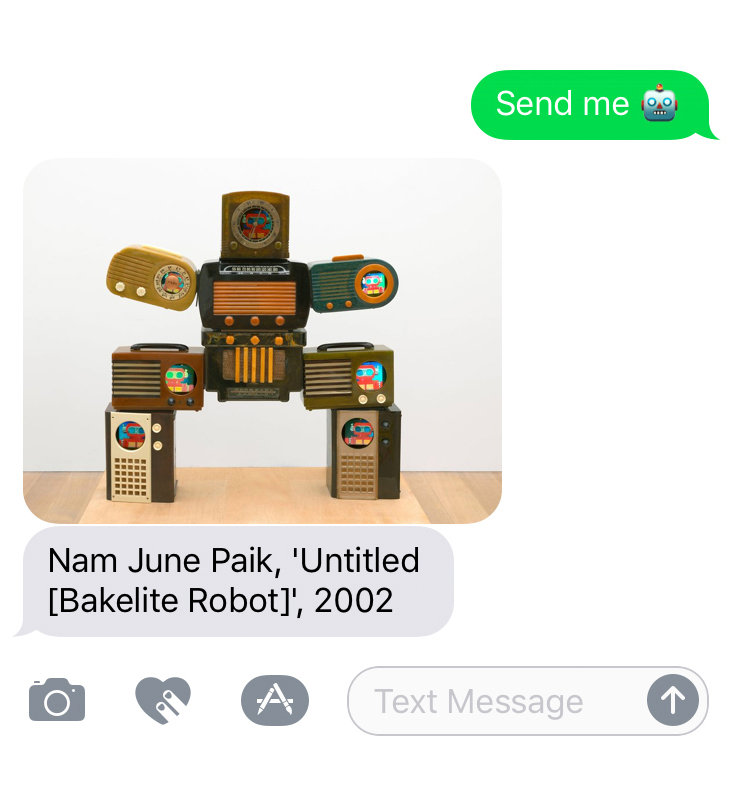New York- Can you trade a smiley face for a Picasso? The San Francisco Museum of Modern Art has given you the chance to try.
Over the last few weeks, the museum has invited people to text the number 57251 with the phrase “send me” followed by a word or an emoji — send me a robot, for instance. The museum texts back with a related image from its collection:
The project, “Send Me SFMOMA,” has been an ingenious, playful way to inject some rarefied culture into an everyday habit. And for art lovers, it has unearthed some unexpected artworks, long hidden in storage, along the way.
Begun quietly last month, the project has become a viral hit, with over two million text messages delivered since Sunday alone, said Keir Winesmith, head of web and digital platforms for SFMOMA. (The service is free.)
It’s far more popular than the museum ever imagined, with people indulging in a long back-and-forth, binge texting. And it’s also revealed something surprising about its users — about how, and when, they want to interact with art, and how much they crave a personal connection with cultural authority.
Can texting a museum be the start of a meaningful cultural conversation? SFMOMA thinks so.
At a time when “public trust in institutions is very low,” Mr. Winesmith said, “Send Me” offers another kind of relationship. “We want it to feel like you’re communicating with a friend.”
A potentially uplifting friend, at that: Most of the texts yearned for positivity, requesting love, flowers and happiness, he said.
Inspiration was another big search term, along with appeals for hope, peace and joy. But sadness ranked in the top 20 searches, too.
The top emoji requests included the robot, the heart and the rainbow,” Mr. Winesmith said. “And then, because it’s the internet, it’s a lot of food and a lot of animals.”
He discovered that the museum had a surprising quantity of vegetable art. The cactus emoji has been a sleeper hit, too.
The texts that have come pouring in at night are different — more intimate, Mr. Winesmith said, with searches for words like “family” and “home.” People also ask to see nudes — but the program is designed to deny them, for now.
The idea for “Send Me SFMOMA” sprang naturally from work that the museum was already doing, especially as part of its reopening after an expansion last year. Mr. Winesmith said they wanted a way to open up the collection of about 34,000 art works for the public — something with almost no barrier to entry, no apps or downloads. The project uses the roughly 17,000 works that are already indexed online, on the museum’s website, as its base.
But the museum’s artistic responses aren’t always obvious, and they can be humorous or ironic, with a curated feel — the result of smartly applied keywords. Heather Oelklaus, an artist from Colorado Springs, sent in the gun emoji, and received Andy Warhol’s “Triple Elvis.” (In the painting, Elvis holds a gun.)
Responding to emoji texts proved to be among the biggest challenges for the developer, Jay Mollica. Mr. Mollica, the museum’s creative technologist, conceived of the project, but he is not an avid emoji user, and Mr. Winesmith admitted that his own emoji vocabulary was “limited.” So the museum recruited more fluent employees and set up a daylong “emoji boot camp” to understand the nuances of the characters. (“A peach is euphemistic for a bottom — we didn’t know that,” Mr. Winesmith said.)
Not all the emojis or word prompts have artwork associated with them. Mr. Winesmith’s team has been busy filling the holes. On Monday, “send me feminism” returned nothing; on Tuesday, a Judy Chicago work popped up.
They now have more than 200 emojis mapped. But some will never be matched: the alien head, for one. “We literally don’t have aliens in our collection,” Mr. Winesmith said.
Accessing collections with everyday language — rather than the specialized terms employed by archivists and art professionals — is “a sea change” in the way museums work, said Zachary Kaplan, executive director of Rhizome, a nonprofit that specializes in digital culture.
And it’s a shift led by our tech habits: “A generation has been raised querying Google,” Mr. Kaplan said, and now there’s an assumption that a museum should be as easily searchable. Some institutions, like the Cooper Hewitt, which allows visitors to search its archives by color, are trying to adapt.
To Ms. Oelklaus, the Colorado artist, that didn’t matter. She texted the museum 35 times in two days, she said, finding her own meaning. She began by typing “empty nest,” because her daughter is about to leave for college.
“I got quickly addicted to it,” she said. The more she texted, “the more interesting it was, reflecting on what I wanted to see.”
The New York Times
